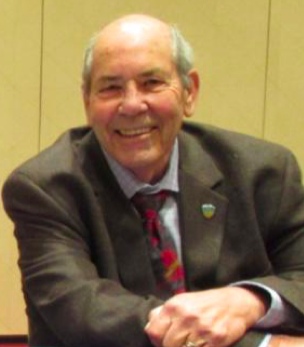My AgSafeBC Story
Ralph McGinn

"My proudest claim about FARSHA is that the sector's injury rate was almost 7% in 1992 and with the efforts of FARSHA, now AgSafe, employers, workers and the WCB, the injury rate is now just about 2% - a remarkable achievement."
The Farm and Ranch Safety and Health Association (FARSHA), now AgSafe, was created in 1993 as a result of the ag industry becoming regulated under the Workers Compensation Board (WCB) Act.
The concept was an agreement between the Canadian Farmworkers’ Union (CFU) and ag employers that a health and safety agency was required to assist employers to comply with regulations, and to train and educate workers in safe and healthy work practices. It was the first occupational safety and health (OSH) association in B.C. and today AgSafe is distinguished as having the only Board with equal members from labour and employer bodies.
At the time I was the Vice-President of the WCB prevention division and the WCB non-voting representative on the FARSHA board. I served as the representative on the board from 1993 to 1998. I retired from the WCB in 2003.
In 2006 Mark Thompson, the original Chair of FARSHA, announced that he was retiring as Board Chair and I was asked by the Board to compete for the position. I served as FARSHA/AgSafe Board Chair from early 2006 to 2018.
Since an OSH association was a new concept I felt it had an important role to play in improving health and safety in the industry. The WCB has never had sufficient prevention resources to inspect the approximately 400,000 workplaces in B.C. for compliance with regulations, and could not be expected to train and educate all workers and employers in safe work practices. As such, FARSHA had an important and valuable role to play. I also thought if it was successful then the concept might be replicated in other industry sectors, and it has. The model has been replicated in 12 other industry sectors – a testament to FARSHA’s success.
My proudest claim about FARSHA is that the sector’s injury rate was almost 7% in 1992 and with the efforts of FARSHA, now AgSafe, employers, workers and the WCB, the injury rate is now just above 2% - a remarkable achievement.
FARSHA has grown significantly since 1993 from a staff of 2 plus 1 safety consultant and a few contract consultants, to rebranding as AgSafe with a staff of 4 and 12 regional safety consultants and advisors.
My hope for the future of FARSHA/AgSafeBC is that the organization will continue to thrive and be seen as a valuable asset to the farming and ranching community.
The concept was an agreement between the Canadian Farmworkers’ Union (CFU) and ag employers that a health and safety agency was required to assist employers to comply with regulations, and to train and educate workers in safe and healthy work practices. It was the first occupational safety and health (OSH) association in B.C. and today AgSafe is distinguished as having the only Board with equal members from labour and employer bodies.
At the time I was the Vice-President of the WCB prevention division and the WCB non-voting representative on the FARSHA board. I served as the representative on the board from 1993 to 1998. I retired from the WCB in 2003.
In 2006 Mark Thompson, the original Chair of FARSHA, announced that he was retiring as Board Chair and I was asked by the Board to compete for the position. I served as FARSHA/AgSafe Board Chair from early 2006 to 2018.
Since an OSH association was a new concept I felt it had an important role to play in improving health and safety in the industry. The WCB has never had sufficient prevention resources to inspect the approximately 400,000 workplaces in B.C. for compliance with regulations, and could not be expected to train and educate all workers and employers in safe work practices. As such, FARSHA had an important and valuable role to play. I also thought if it was successful then the concept might be replicated in other industry sectors, and it has. The model has been replicated in 12 other industry sectors – a testament to FARSHA’s success.
My proudest claim about FARSHA is that the sector’s injury rate was almost 7% in 1992 and with the efforts of FARSHA, now AgSafe, employers, workers and the WCB, the injury rate is now just above 2% - a remarkable achievement.
FARSHA has grown significantly since 1993 from a staff of 2 plus 1 safety consultant and a few contract consultants, to rebranding as AgSafe with a staff of 4 and 12 regional safety consultants and advisors.
My hope for the future of FARSHA/AgSafeBC is that the organization will continue to thrive and be seen as a valuable asset to the farming and ranching community.
